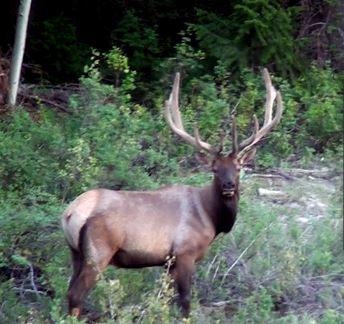Elk, majestic creatures that roam the vast landscapes of North America, have captivated the hearts and minds of outdoor enthusiasts, wildlife enthusiasts, and hunters alike. There are multiple species of elk in the United States. The species that we will be focusing on is the rocky mountain elk. The Shawnee called these elk Wapiti meaning white rump or white deer. TFound primarily in North America, they inhabit a range of environments, from forests and mountains to grasslands. The male elk, known as bulls, are characterized by their impressive antlers, which can span up to four feet. Female elk, or cows, lack antlers.
Habitat
Rocky Mountain elk by their namesake are found in the mountains. These animals usually run the tops of mountains. They like forested areas that give lots of cover from any predators in the area. They also are usually pretty close to a water source. A good rule of thumb is to find a water hole in the mountains half a mile away from a road. Elk are highly adaptable animals, and their habitats can vary widely. They are found in diverse ecosystems, including coniferous forests, aspen groves, and alpine meadows. Their range extends from northern Canada down to the northern parts of Mexico. Elk are known to migrate seasonally, moving to lower elevations in the winter and higher elevations in the summer.


Elk Characteristics
Elk are tan, black, and white. Females (cows ) usually roam in large herds with one main male (bull ) and a few other bulls that follow the main herd called satellite bulls. They have a black neck that usually has longer hair that shrinks into the tan body fur. They also have white butts.
Antlers
Only bulls have antlers. A mature elk’s antlers usually have one main beam with six smaller points coming off the of it. They will usually have two points near the base of their antlers with a third antler about halfway up their antler. They then have three points up near the top of their antlers (See picture below). The bulls will shed their antlers usually in May or April of every year as their new antlers start to grow. Their antlers will grow from when the last set shed off until September when they scrape off the velvet that helps their antlers grow.

Elk Sounds
Both bull elk(male) and cow elk (Female) make different sounds. Cows make a high pitched mewing sound. Bulls will bugle at each other to declare dominance and to challenge other bulls. Bulls will also make a hissing noise to help threaten other bulls. Younger bulls will also mew like cows.
Rut
The rut, which is in September, is breeding season for elk This is when you will hear the big bulls be very vocal and start claiming their cows. A good way to get an eye on this action is to use trail cameras. Trail cameras allow you to view these awesome moments without disturbing them. If you want to use trail cameras to view these moments and don’t know which one to use, click the trail camera review button below!